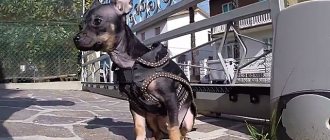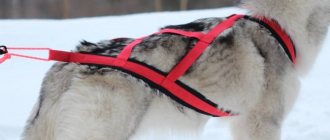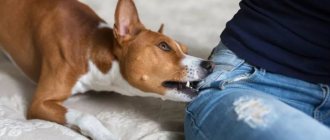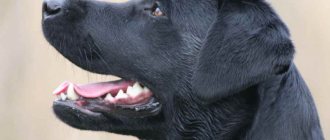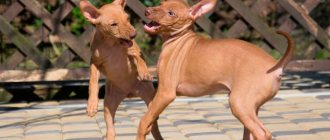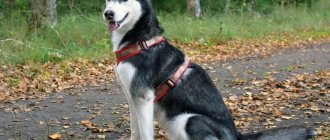Collars, leashes and harnesses are necessary items for those who have a dog in the house. It doesn’t matter at all what size, breed, weight it is, it’s impossible to even imagine a walk without them. A harness is considered less traumatic than a collar. It is securely fixed on the shoulders and chest. To prevent this harness from causing discomfort to your pet, you need to know how to put a harness on a dog - step by step instructions will be in the article.
Both harnesses and collars have probably been used as long as dogs have been living side by side with humans. Initially, harnesses were used to harness sled dogs. For transporting goods and people, a regular collar was inconvenient. It puts too much pressure on the animal's neck and often causes injury.
The harness has no such drawback. It allows you to evenly distribute a large load, without harm to the dog’s health. This accessory is still used today. It is popular with owners of small dogs and for overly active pets. It is not easy to keep animals on a collar while walking. With sudden movements, the dog simply hangs on the collar, which often leads to serious injury and even more tragic consequences.
Types and types of harnesses
| View | Design Feature | Purpose |
| Walking | It is attached to the leash using special rings located at the withers. For large dogs, such harnesses have a felt layer to reduce the load on the chest area. | Regular pet walking |
| Riding | The design is equipped with straps that help reduce the load on the pet's shoulders. The harness has fasteners to fasten the dog directly to a sled or other harness. | Designed for sled dogs that run in sleds and carry loads |
| For towing | Very durable design, designed for powerful, large dogs. Equipped with special rings and reliable belts. Steel rings are located not only in the withers area, but also in the side part. | Transportation of heavy loads, transportation of children on sleds, carts. Often used for sports competitions. |
| Cargo | Equipped with pockets for storing heavy items | To train the dog's strength and endurance, preparatory classes before competitions or exhibitions |
| In the form of a vest | Reminiscent of a vest for small dogs with a special leash attachment | Serves as a harness and warm clothing. Often chosen by owners of dwarf dogs. |
| For correction | The leash ring is located in the chest area. | Allows you to wean your dog from pulling on a leash. Due to the design feature, when making a sudden movement, the dog simply turns to face the owner. You can correct the animal's posture. |
| Medical purpose | They resemble a vest that practically fits completely on the dog. Rings for the leash are located in the area of the hind legs | Treatment of dogs with injuries and paralysis |
| Puppy | Made from soft materials that can hold a puppy | Allows you to train puppies to walk on a leash. Cannot be used before 9 or 10 months! |
In addition to these, there are other types of harnesses. They can be used for exhibitions. Available with special handles. Such accessories are intended for large dogs. A convenient handle on the back allows you to hold your pet if necessary.
Types and types of harnesses
Knitted clothes
If you are not comfortable with a needle and thread, but are great with knitting needles, then we hasten to please you - knitted clothes for dachshunds are easy to make and practical, just like those made from fabric. For this work, 200 g of any yarn of medium thickness will be useful: perhaps you have a ball lying around from a previously knitted scarf or sweater, or you purchased a warm woolen thread especially for this case. Here are some tips for creating a stylish sweater:
Start knitting it from the neck.
- On the back side, reduce the number of stitches to avoid the formation of folds and wrinkles.
- The sleeve knitting technique is similar to the technique for the fingers of gloves.
- Decorate the finished sweater with decor or add buttons.
The variety of yarn colors allows you to create not only clothes that are comfortable for your dachshund, but also a whole work of design art.
Advanced knitters can afford to give their pet a whole costume: a warm blanket or sweater and boots in case of particularly severe frosts. An evening of work will be fully repaid with doggy joy.
Choosing the right harness for your dog
In order for the harness to be comfortable and serve for a long time, you need to choose it correctly:
- Quality of material. The accessory should be easy and simple to care for;
- Strength and lightness of the fastening structure. The harness should be easy to fasten and remove. At the same time, the carabiners should not restrict the dog’s movement.
- Dimensions, dimensions and weight of the dog. The harness, its carabiners and fastenings must be reliable and designed for the strength and size of the pet. A powerful alabai will easily fall off the harness, which has plastic fastenings. And a small Chihuahua will not be able to take a step if he is wearing a heavy harness.
Criteria for choosing a collar for an orange
Pomeranians have incredibly thick and soft fur, which is something to consider when choosing a collar. The accessory should not “chew” or cling to the fur or tear it out. Excessively heavy and massive models can rub the dog’s skin on the neck, which also leads to hair loss. Thus, an incorrectly chosen collar leads to the formation of many tangles and baldness.
One of the fashionable solutions for the Pomeranian is a metal chain around the neck instead of a collar - in fact, an extremely inconvenient and traumatic accessory. It is prohibited to use it constantly and every day.
In addition, some Pomeranian owners want to turn their pet into a spectacular toy dog. Moreover, the dog’s comfort is not taken into account in this situation. You cannot buy devices with a scattering of rhinestones and shiny convex dots. Such small parts cling to the animal’s fur, causing it severe discomfort.
Nylon and fabric accessories are prohibited, as they instantly wear out and irritate the four-legged skin.
At what age should you start putting a harness on your dog?
The most suitable age for wearing a harness is when the puppy is already physiologically mature. That is, he has grown up enough, has strong bones and developed muscles. Otherwise, you can seriously harm your pet. Immature bones can become deformed and joint diseases can occur. This will require serious treatment in the future.
Each breed has its own characteristics and growth rate. It must be remembered that:
- Dwarf dogs grow faster. By about 6 months they are already sufficiently formed. Therefore, by this age the puppy can be taught to walk on a harness. You can use both a collar and a harness. This will reduce the load on joints that have not yet become stronger.
- The development of large dogs is slower. Their bones and muscles are ready to wear a harness at around 9 months. However, it is worth remembering that large dogs are predisposed to joint dysplasia. It will be better if walks with a harness are postponed until a year. This will reduce the stress on your joints.
How to choose the right harness for your dog
So, you need to choose a harness taking into account many parameters. Choose based on the size, breed, and age of the dog. The accessory must be of high quality, easy to care for and comfortable for the dog. In addition, its purpose should be taken into account.
How to choose the right harness
Sizing
The equipment is selected strictly according to the size of the dog. It should fit tightly, not press, but not be too loose. It is best to take your pet's measurements before purchasing. In this case, there is less chance of “missing the mark” with the size.
Selection of harness size
- You need to determine how big your neck is. To do this, you need to measure your neck with a regular centimeter used by seamstresses. The reference point will be the first bone in the throat area.
- You also need to measure your chest. At the widest point. In the area of the front paws.
- Back length. You need to know the length of the back from the collar to the base of the tail.
In this case, you should add a couple more centimeters to the freedom of fit. If the fur is too fluffy, it needs to be pressed down. You can adjust the equipment to your dog using special belts.
Material selection
Harnesses can be made of different materials. The material should be soft, but at the same time strong. Suitable for nylon or nylon harnesses. It is worth paying attention to the quality of the lining. It should not cause discomfort to the pet or cause chafing. Tarpaulins are not suitable for harnesses because they have rough seams and are too stiff.
If the pet is small and weighs no more than 3 kg, then velor would be the best option. There should be a handle on the harness. This will allow you to pick up the dog.
Types of fasteners and belts
Particular attention should be paid to the quality and reliability of fasteners. They should open and close easily. It will be more convenient to use a harness with several fasteners. In this case, it is easier to adjust the ammunition to the size of the pet.
Types of fasteners and straps for harnesses
If the fastening is too weak, then such a harness will be uncomfortable. He can easily get out of it during a walk. For a large dog, brass or metal fasteners will be the most reliable.
The number of belts and types of belts may vary depending on the type and purpose of the harness. So, walking ones, for example, have several belts.
Harness for a small dog
A velor harness will do. A dog weighing no more than 3 kilograms will be comfortable in it. It would be preferable to have a handle.
Harness for a small dog
Harness for a large dog
The material for a large pet must be durable and have reliable seams. It is best if it is leather in several layers. It is necessary to have a special fabric, for example, felt, as a layer, which will reduce the load and pressure on the joints.
Harness for a large dog
Unrecognized
Breeds not recognized by the FCI include:
- Norwegian sports mestizos;
- Eskimo husky;
- wolf-dog;
- Sakhalin Husky;
- Chinook.
Norwegian sporting crossbreeds
Norwegian mixed breed
Norwegian mestizos are the fruit of the painstaking work of the hands of breeders who carried out matings between:
- greyhounds;
- kurtshaars;
- pointers.
The dog was created specifically to participate in sports competitions and has good physical characteristics combined with a gentle disposition.
Buying such a puppy is not easy. Due to the lack of official confirmation, it is difficult to confirm the quality of the animal being purchased.
Eskimo Husky
Eskimo Husky
North American native dog of medium size. The animal is not suitable for families with small children and needs access to constant work.
The Laika is quiet, friendly, hardworking and has hunting skills. The fearless animal was used to hunt polar bears.
The pet is not suitable for keeping in warm climates and is susceptible to sunstroke.
Due to their rarity (there are no more than 5 hundred officially registered animals), the cost of puppies reaches 420 thousand rubles.
Wolfdog
Wolfdog
Wolfdogs are unique hybrids obtained by crossing wild wolves and German shepherds. The attractive appearance inherited from the wolf and the character inherited from the shepherd allowed the animal to be used in dog sledding and service work.
It will not be possible to purchase such a pet, since sales are prohibited. The breeding project and the results obtained belong to Russian scientists.
Sakhalin Husky
Sakhalin Husky
The result of crossing Akita Inu and Spitz from Japan. Animals are fearless, prone to dominance and strongly attached to their owners.
With prolonged loneliness, Sakhalin residents develop severe psychological problems leading to physical illnesses. Prices for puppies start from 20 thousand and reach 50 thousand rubles.
Sakhalin Huskies are not suitable for apartment living and will throw a real concert after the owner leaves for work. At the same time, they perceive the harsh conditions of the Far North with ease, enjoying participation in human expeditions.
What material to choose a harness from?
The final choice of harness and the material from which it is made depends on the preferences of the dog owner.
Synthetic
Such materials are the easiest to care for, they are durable and have a long service life. Nylon has these qualities. It does not lose its qualities, the seams are durable. Nylon is not afraid of sharp dog teeth. However, there is a possibility that your pet may be allergic to this material.
Synthetic dog harnesses
Canvas
Such harnesses belong to the budget price category. The tarpaulin is quite durable. But it also has its drawbacks. It is short-lived, absorbs moisture well and dries slowly.
Canvas dog harnesses
Leather
Harnesses can be made of genuine leather or its substitute. You shouldn't count on long-term leather service. Genuine leather has the property of stretching. Especially, she is often wet. Artificial material does not withstand regular walks in the cold. Over time it deteriorates.
Leather harnesses for dogs
Popular models of walking accessories
Owners of Pomeranian Spitz dogs can easily choose a harness or other walking accessory, because a huge number of foreign and Russian models are currently produced. Today there are three popular brands of walking accessories for Pomeranians.
EzyDog
Collars from Australia, designed for both decorative and large breeds of dogs, regardless of age. EzyDog ammunition belongs to the premium class, and the price of devices starts from 2 thousand rubles. But the rather high cost is fully justified by the quality of the product. The collars are made of the strongest material that repels water, are easy to clean, and can be placed on the Pomeranian’s neck without any problems. In addition, the EzyDog fasteners are of European design.
Collar
Collars from Ukraine, which are divided into several lines: “Glamour”, “Soft”, “Brilliance”. While “Glamour” and “Brilliance” are intended for formal and festive occasions, the “Soft” line is designed for everyday wear. These are models with a round cross-section that fit perfectly on oranges. They do not “chew” the wool and do not wear out. The clasp is made of stainless steel. The price of Collar accessories starts from 250 rubles.
ForMyDogs
This is a Russian manufacturer that produces several lines for decorative breeds. For example, the “Velvet” line of collars is made of leatherette and lined with velvet. These are very soft collars made of wear-resistant material. Harnesses are also produced under the ForMyDogs brand. The cost of goods starts from 650 rubles.
Which is better - a harness or a collar?
Each of the common types of ammunition for four-legged pets has pros and cons. According to dog handlers, the first equipment for a puppy should still be a soft collar.
The fact is that with the help of a collar it is easier to control the dog and train it. Only after your pet has mastered the basic commands can you begin to accustom him to a harness. For dogs with aggression, it is worth choosing a collar.
The harness is also a universal option for ammunition. If you choose it correctly, your pet will be able to enjoy walks.
Therefore, you need to choose one or another option, taking into account the character of the pet, the degree of its controllability, and the characteristics of the breed.
How to put a harness on a dog - step-by-step instructions
The harness does not have the simplest and most understandable design. There is a possibility that there may be minor errors. The dog will also have to get used to the new accessory. Therefore, there may be attempts to get out of it.
There are two ways to put on the harness. We will look at them below.
The first way to put on a regular harness.
Putting a regular harness on a dog is not very difficult. The owner's actions must be confident. You can stock up on treats for your pet.
The procedure will be as follows:
- If the dog is nervous and worried, then you should calm it down;
- It will be difficult to cope with an active pet alone, so you can invite an assistant. Especially if the dog is large.
- Take the harness in your hands and let the dog sniff it so that the dog understands that this object will not harm it;
- If the dog behaves calmly, give him a treat and praise him;
- Fix the dog in the desired position (squeeze it between your knees);
- The harness has three straps. One should be in the chest area, the second below it, and the third should secure the dog in the area just below the chest.
- If the dog understands the “give paw” command, then you can take advantage of this. There is a hole between the straps. Raising your paws one by one, stick them into it.
- Now use the straps to tighten the structure and fit it on your pet.
- Give a treat and praise the dog.
- The harness should fit tightly on the pet.
- Fasten the carabiner, which is located in the withers area.
If everything is in order, then you can attach the dog to a leash and go for a walk.
The second way to put on a regular harness.
You can put the harness over the paws. They do it like this:
- Place the harness on a flat surface, for example, on the floor;
- Now you need to call your pet. Small dogs are picked up;
- The dog is placed in the holes between the cross belt so that the paws get into them;
- Now all that remains is to tighten the structure and fasten it on the back using a carabiner.
- If the harness is worn correctly, it will not cause discomfort to the dog.
Harness with two holes for the body and head, riding
Dressed in approximately the same way as in the very first version over the head:
Harness with two holes for the torso and head
- The dog must stand in front of the owner;
- It is fixed with the help of the knees (gently squeezing the sides);
- The head is threaded through a special hole between the straps;
- Bend the right paw and thread it into the hole on the desired side;
- Then the same operation is performed on the left;
- Snap the harness using a carabiner.
Harness-vest
If the vest fastens on the back, then you can put it on the dog using one of the methods described above. Sometimes the design is fastened with a carabiner located in the chest area.
Harness vest for dogs
Then the procedure will be slightly different:
- Approach your pet. Place the vest on your back;
- Bend your right paw at the elbow and insert it into a special hole;
- Then do the same with the left;
- Fasten the carabiner on the chest.
In principle, nothing complicated. The algorithm of actions is the same as in the case of a sweater, jacket or other clothing with buttons on the chest.
How to put a harness on a large dog
Dealing with a large dog is even easier than with a small one. The main thing is that no one gets nervous. Neither the pet nor the owner.
- Approach the dog.
- Fix in the manner indicated above;
- Straighten the accessory. The harness is put on so that the soft insert is in the chest area;
- Take the dog by the left paw, bend it at the elbow and pass it through the corresponding hole;
- Do the same with the right one.
- If the harness is worn correctly, the belt will be on the chest;
- Don't rush and put pressure on the animal. Nervous and uncertain movements will only frighten the dog.
- At the right moment, they distract her, bark a treat, and stroke her.
- The harness is secured with a special carabiner.
Then it is adjusted to the dog’s “figure” using special fasteners.
How to put a harness on a small dog
The second method is suitable here. The dog is picked up, the harness is straightened and its paws are placed in the required holes. After which the procedure is similar.
Sewing a harness-vest
A vest style harness is usually used for small dogs and puppies as it is softer and more comfortable. In such ammunition, the animal will not suffer, even if it jerks sharply when scared or in an attempt to run somewhere.
Upon completion of the preparatory stage, they begin cutting out the future product. When sketching a pattern on paper, do not forget to leave 2 cm in reserve on all sides. In addition to the base, the same piece or two are made for the soft lining. Cut out blanks from fabric.
How to sew a harness-vest for a dog with your own hands:
| Step | Visual photo |
| Cut a strip of fabric along the length of the workpiece. They bend it and iron it | |
| Place the piece in the middle of the pattern | |
| A ring is fixed in the center | |
| Fold both parts of the pattern right side together and stitch, leaving a small area to turn the product inside out. After this, sew it up with a neat stitch. Velcro fasteners are sewn to all ends of the vest | |
| The finished vest should look neat |
A long leash is attached to the ring. As the pet grows, instead of linden, the ends of the product are hemmed with straps, which can also be equipped with Velcro to adjust the size.
If leather was chosen for sewing and the finished product turned out to be too small, then it is possible to stretch it. This is done as follows:
- Immerse in water for half an hour.
- Take it out and wrap it around some round object - cans, cans, buckets.
- After complete drying, the leather is treated with shoe polish or industrial fat.
What to do if your pet resists?
As a rule, dogs are afraid of everything new and unfamiliar. In the case of a harness, you shouldn’t expect your pet to stand “at attention” and endure it. Most likely, he will try to break free and get rid of the unknown object.
It is quite possible that it will take some time to get to know the harness. You need to introduce the dog to her. That is, let her sniff and show that the object is not dangerous for her. During the fitting process, act calmly but persistently. Encouraging him at the right moments with treats and petting.
If the dog growls and breaks out, punish and stop. You need to be able to insist on your own.
Choosing a tape measure for orange
A tape measure is a very convenient walking device. Its advantage was the stable and inextricable connection between the owner and the pet. In other words, at any time you can adjust the movement of the dog and take control of the situation.
Roulettes come in cable and tape types. The latter are considered safer for Pomeranians. Roulettes from Germany and Italy have proven themselves.
Choosing a tape measure is quite simple: each model indicates the maximum allowable weight of the animal. Other qualities of the right tape measure for Pomeranians are:
- strong plastic case with no sharp edges or gaps;
- tight assembly;
- non-slip and non-massive handle;
- the spring moves very smoothly;
- the lock is reliable and does not slip;
- powerful carbine.
